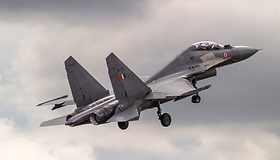

Exercise Indradhanush IV (in Hindi meaning Rainbow) was held during the last two weeks of July 2015. The fourth exercise of its type, this year it was turn of the Indian Air Force (IAF) to visit UK shores. The IAF deployed four of its Sukhoi Su-30MKI ‘Flankers’ to Royal Air Force (RAF) Coningsby in Lincolnshire which was the base to be used for the exercise. The Su-30s came from 2 Sqn 'The Winged Arrows' which are based at Tezpur near India’s border with China.




Indra Dhanush 2015, RAF Coningsby, England
Support aircraft arrived in the form of C-130J Hercules and C-17A Globemaster III, bringing along IAF crews amounting to 15 pilots and 5 weapon systems operators. An IAF IL-78 was also present but was based at RAF Brize Norton. This aircraft was used for air-to-air refuelling of SU-30 aircraft during the exercise.








The aim of the exercise was to practice air-to-air combat. The IAF was up against the RAF's 3 Sqn Typhoons which led the exercise. Once airborne the aircraft would fly to the combat theatre over the North Sea and carry out 1vs1, 2vs1 and increasingly complex engagements.
According to reports the Flanker pilots used their thrust-vectoring control system to great effect allowing them to manoeuvre in such a way to remain inside the tight turn radius of the Typhoon in order to keep the aircraft in missile launch parameters.




The Royal Air Force and Indian Air Force both acknowledged the exercise as a major success. Bridges between the two countries continue to be built and collaboration amongst air forces in today's world economic climate is as important as ever.
The specific outcomes of the dog-fighting activities from both sides remain classified for the time being. The last exercise mission saw all four Flankers working with six Typhoons to escort and support two C-130J Hercules on a paradropping mission.
Missions often involved all four Su-30s flying beyond visual range and within visual range engagements against the Typhoon.

